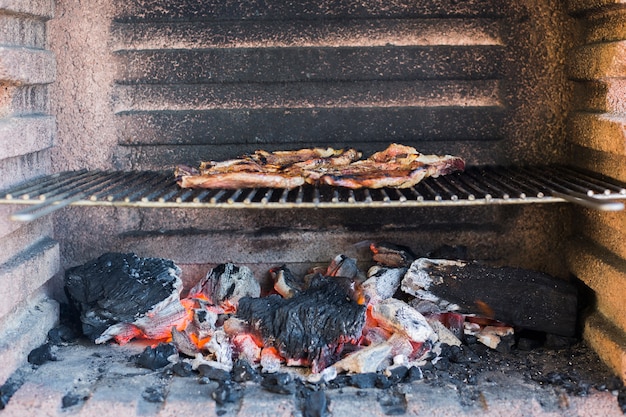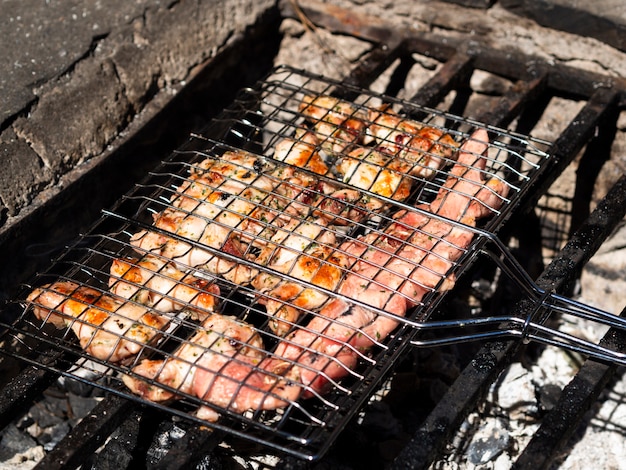How long to cook BBQ chicken indirect heat?
When it comes to cooking BBQ chicken, using indirect heat is a popular method that results in juicy and flavorful meat. Indirect heat involves placing the chicken away from the direct flames or coals, allowing it to cook slowly and evenly. This method is ideal for larger cuts of chicken or when you want to infuse the meat with smoky flavors.
The basics of cooking BBQ chicken with indirect heat
To cook BBQ chicken using indirect heat, you will need a barbecue grill with a lid. Start by preheating your grill to a medium temperature, around 350-375°F (175-190°C). Prepare the chicken by seasoning it with your preferred rub or marinade.
Next, arrange the charcoal or gas burners on one side of the grill, leaving the other side empty. This creates two cooking zones: direct heat and indirect heat. Place the chicken pieces on the side of the grill opposite the heat source, ensuring they are not directly over the flames or coals.
The cooking time for BBQ chicken
The cooking time for BBQ chicken using indirect heat varies depending on several factors, including the size of the chicken pieces and the temperature of the grill. As a general guideline, bone-in chicken pieces such as thighs and drumsticks may take around 40-50 minutes to cook thoroughly. Boneless chicken breasts or wings will usually cook faster, about 20-30 minutes.
It is crucial to monitor the internal temperature of the chicken using a meat thermometer to ensure it reaches the safe minimum internal temperature of 165°F (74°C) for poultry. Insert the thermometer into the thickest part of the meat without touching the bone for accurate readings.
Tips for perfect BBQ chicken
- Pat the chicken dry before seasoning to ensure a nice sear and crispy skin.
- Use a combination of direct and indirect heat for a perfectly cooked chicken with a charred exterior and juicy interior.
- Baste the chicken with your favorite BBQ sauce during the last 10 minutes of cooking for added flavor.
“Cooking BBQ chicken with indirect heat results in tender, moist meat bursting with smoky flavors. The low and slow cooking method allows the chicken to cook evenly while retaining its natural juices.”
Should you grill chicken direct or indirect?
When it comes to grilling chicken, one of the most important decisions you’ll need to make is whether to cook it directly over the heat (direct grilling) or indirectly with the heat source off to the side (indirect grilling). Both methods have their merits, but it ultimately depends on what you’re looking to achieve with your grilled chicken.
Direct Grilling
Direct grilling involves placing the chicken directly over the heat source. This method is great for quick cooking and achieving a crispy exterior. It’s perfect for smaller cuts of chicken, such as chicken breasts or thighs. The high heat sears the chicken, locking in moisture and creating that desirable grill mark.
Advantages of direct grilling:
- Quick cooking time
- Crispy exterior
- Perfect for smaller cuts
Indirect Grilling
Indirect grilling involves cooking the chicken with the heat source off to the side, creating an oven-like environment. This method is ideal for larger cuts of chicken, such as whole chickens or roasts. The lower temperature and longer cooking time allow the chicken to cook evenly and retain its moisture.
Advantages of indirect grilling:
- Even cooking
- Retains moisture
- Great for larger cuts
“Direct grilling is perfect for those who prefer their chicken with a crispy exterior, while indirect grilling is ideal for achieving juicy and tender results.”
Ultimately, the decision between direct and indirect grilling depends on your personal preference. If you’re looking for quick, crispy chicken, direct grilling is the way to go. However, if you want tender, juicy chicken, indirect grilling will yield the best results. Whichever method you choose, remember to always cook your chicken to the appropriate internal temperature to ensure it’s safe to eat.
Do You Cook Chicken Legs on Indirect Heat?
When it comes to cooking chicken legs, there are several methods you can use. One popular technique is cooking them on indirect heat. Indirect heat allows for slower cooking, resulting in juicy and tender chicken legs. So, should you cook chicken legs on indirect heat? Let’s find out!
The Benefits of Cooking Chicken Legs on Indirect Heat
Cooking chicken legs on indirect heat offers a range of benefits. Firstly, it helps prevent the exterior of the chicken legs from burning while ensuring the meat cooks thoroughly. Indirect heat also allows the fat to render slowly, resulting in moist and flavorful meat.
Furthermore, cooking chicken legs on indirect heat gives you more control over the cooking process. By adjusting the heat zones on your grill or by using a two-zone setup in your oven, you can maintain a consistent temperature and avoid overcooking or drying out the chicken.
How to Cook Chicken Legs on Indirect Heat
- Prepare your grill or oven for indirect cooking. For a grill, this involves setting up a two-zone fire by placing the charcoal or burners on one side and leaving the other side empty. In an oven, you can create indirect heat by placing a drip pan underneath the chicken legs.
- Season the chicken legs with your favorite spices and marinades. Allow them to rest at room temperature for about 30 minutes.
- Place the seasoned chicken legs on the cooler side of the grill or in the oven above the drip pan.
- Cook the chicken legs at a temperature of around 325°F (163°C) for approximately 40-45 minutes, or until the internal temperature reaches 165°F (74°C).
- For extra flavor, you can baste the chicken legs with your choice of sauce or glaze during the last 10 minutes of cooking.
- Once cooked, remove the chicken legs from the heat and let them rest for a few minutes before serving.
Tip: If you prefer crispy chicken skin, you can sear the chicken legs over direct heat for a couple of minutes at the beginning or end of the cooking process.
In Conclusion
Cooking chicken legs on indirect heat is a fantastic method that results in tender, flavorful, and evenly cooked meat. Whether you’re using a grill or an oven, the indirect heat technique gives you more control over the cooking process, allowing you to achieve delicious results every time!
Can you grill steak on indirect heat?
Grilling steak is a popular cooking method, but have you ever wondered if you can grill steak on indirect heat? While grilling steak directly over high heat is the traditional method, using indirect heat can offer some unique advantages.
What is indirect heat?
Indirect heat involves cooking food using heat that is not directly underneath the cooking surface. This is typically accomplished by setting up a two-zone fire on your grill. In one zone, you create a hot direct heat area, and in the other zone, you create an indirect heat area.
The benefits of grilling steak on indirect heat
Grilling steak on indirect heat allows for more controlled cooking, especially for thicker cuts. It helps to prevent the exterior from burning before the interior reaches the desired doneness. With indirect heat, you can achieve a perfectly cooked steak with a beautiful sear without the risk of charred or overcooked areas.
Additionally, using indirect heat can be beneficial when grilling large or bone-in steaks. The slower and gentler heat allows the meat to cook evenly, ensuring that the center is fully cooked while still maintaining a juicy and tender texture.
How to grill steak on indirect heat
- Preheat your grill by only igniting half of the burners or placing the charcoal only on one side.
- Sear the steak over direct heat for a few minutes on each side to develop a nice crust.
- Move the steak to the indirect heat area and continue cooking until it reaches the desired internal temperature.
- Use a meat thermometer to ensure accuracy. For medium-rare, the temperature should be around 135°F (57°C).
- Let the steak rest for a few minutes before serving to allow the juices to redistribute.
Grilling steak on indirect heat is a great technique to have in your culinary repertoire. It offers more control over the cooking process and can result in a perfectly cooked steak with a delicious sear.
Next time you fire up your grill, consider trying the indirect heat method for grilling steak. It may just become your new favorite way to cook this classic dish.
What Meats Should be Grilled on Indirect Heat?
Grilling is a beloved cooking method in the UK, especially during the summer months. While grilling directly over high heat is ideal for certain cuts of meat, using indirect heat can result in juicier, more tender meat. Indirect grilling involves placing the meat away from the direct flames, allowing it to cook more slowly and evenly.
Benefits of Indirect Grilling
Indirect grilling is perfect for larger cuts of meat that require longer cooking times to reach their desired doneness. It also helps prevent flare-ups, reducing the risk of burnt or charred meat. By cooking with indirect heat, the meat has a chance to develop a delicious smoky flavor without getting overly charred on the outside.
Meats That Benefit from Indirect Heat
1. Whole Chicken: Cooking a whole chicken on indirect heat ensures that the meat remains moist and tender throughout. Start by searing the chicken over direct heat, then move it to the cooler side of the grill to finish cooking.
2. Pork Shoulder: Indirect heat is essential for cooking pork shoulder, commonly used for pulled pork. Slowly cooking the shoulder over several hours allows the collagen in the meat to break down, resulting in incredibly tender and flavorful meat.
3. Ribs: Whether it’s baby back ribs or spare ribs, using indirect heat helps render the fat in the meat, creating melt-in-your-mouth ribs that are still juicy and flavorful.
“Indirect grilling is perfect for larger cuts of meat that require longer cooking times to reach their desired doneness.”
How to Set Up Your Grill for Indirect Grilling
To set up your grill for indirect grilling, follow these steps:
- Preheat your grill to medium-high heat.
- If you’re using a charcoal grill, create a two-zone fire by placing the coals on one side of the grill. For a gas grill, turn off the burners on one side.
- Place the meat on the side of the grill without direct heat.
- Cover the grill and adjust the vents to maintain a consistent temperature.
- Cook the meat according to the recommended cooking times for each specific cut.
By mastering indirect grilling, you’ll be able to elevate your barbecue skills and impress your friends and family with perfectly cooked, juicy meats. So, next time you fire up the grill, consider using the indirect grilling method for that extra tenderness and flavor!


